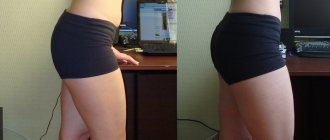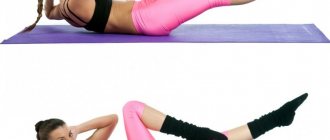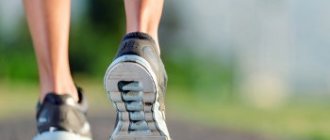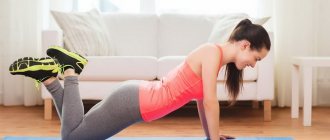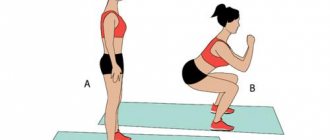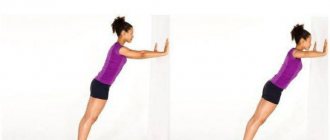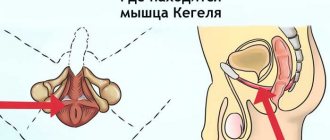How to properly exercise with a fitball?
There are several simple principles for effective training:
- First of all, you need to choose a suitable gymnastic ball, especially for a beginner.
- Conduct classes 1-1.5 hours after eating.
- Before starting the exercises, you need to warm up. This is an important rule for any physical activity. Muscles and joints need to warm up and prepare.
- If you have little experience with a fitball, you can lightly hold the ball with your hands during exercise. Later this need will disappear.
- Fitness classes with a fitball should be carried out at least 2-4 times a week. The duration of one workout is 30-60 minutes.
- If you pump the ball harder, the load during exercise will increase. It will take more effort to impact the fitball.
- It is also recommended to carefully choose the color of the gymnastic ball. It should be pleasant and not negatively affect your mood.
The benefits of fitball exercises
- Significantly reduced weight. By exercising on a fitball, the metabolic processes occurring in the body increase and, accordingly, intensive burning of fat reserves is ensured.
- It is impossible to get any injuries.
- Improves coordination and flexibility.
- Posture becomes correct.
- Muscular endurance increases.
- A beautiful press with relief is formed.
- The double chin disappears.
- Flexibility and grace appear. By doing a fitball for weight loss, you can achieve effective muscle stretching, which is impossible with other exercises.
There are no contraindications for fitball aerobics. It is also suitable for those who suffer from varicose veins. Fitball for weight loss is a multifunctional equipment, thanks to which you can work with all muscle groups. Exercises on a belly slimming ball allow you to strengthen all muscles, increase tone, while there will be no strain on the spine and joints. Choosing a weight loss ball, criteria, some tips and tricks
Choosing the right gymnastic ball
To get maximum results, exercise with an exercise ball should be comfortable. The choice of the fitball itself plays an important role in this. The correct size of the ball is determined by the person's height.
Choosing the best option will help you avoid injuries and sprains:
- Fitballs are 45-95 cm in diameter, with an interval of 10 cm. You must subtract 100 cm from your height. The resulting figure is the required ball diameter. For example, if you are 168 cm tall, you need to purchase a 65 cm fitball.
- You can check the ball in another way. You need to sit on it. Bend your knees. So that a right angle is formed. Press your feet to the floor. If these conditions can be met, the ball is chosen correctly.
- It is believed that with a standard height, an adult can safely use a 75 cm fitball. Without the need for calculations.
- The gymnastic ball must not have any mechanical damage. This way it will be quite elastic. This is a necessary condition for obtaining the effect when performing exercises.
- When purchasing a fitball, you should pay attention to the quality of the material from which it is made. Rubber should not have a strong odor. Its density should be quite high. This is necessary to ensure that the ball does not burst during training. The thickness of the rubber should be uniform. This will help prevent the fitball from becoming deformed in the future.
There are gymnastic balls with small spikes. Thanks to them you can get a light massage effect.
How the ball works
A special exercise ball was invented back in the 50s of the last century. Its author was Swiss physiotherapist Susan Kleinvogelbach. She developed a simulator that could be used to train patients who had suffered serious spinal injuries. The Swiss ball helps you return to normal life faster than any other exercise.
Nowadays, gymnastics with a ball is used not only for rehabilitation, but also for weight loss. The fitball has a fairly impressive diameter - from 45 to 85 cm. You need to choose it depending on your height, the scale should be in the sports store itself, and it is also indicated on the packaging.
Exercises with a ball help to use 2 times more muscle groups than regular workouts, while the metabolic rate increases significantly, which helps to break down and remove fat deposits from the body.
The effect of fitball on the body:
- works almost all muscle groups;
- accelerates metabolic processes;
- helps improve blood circulation in the intervertebral space;
- actively saturates body cells with oxygen;
- improves posture;
- increases flexibility;
- has a positive effect on the functioning of the vestibular apparatus;
- relieves pain, tension and fatigue in the back and lower back.
What does fitball train?
The benefits of exercising with a fitball are undeniable:
- Helps get rid of excess weight.
- Improves blood circulation.
- Helps speed up metabolism.
- Develops and strengthens the muscle corset.
- Makes joints elastic.
- Perfectly develops the vestibular apparatus.
Thanks to the round shape of the gymnastic ball, movements have a large amplitude. And the instability of the fitball leads to constant muscle tension in order to maintain balance. Excellent for physical activity during the rehabilitation period.
Choosing a fitball
You need to choose a ball according to your height - up to 150 centimeters, the ball should have a diameter of 45 centimeters, respectively, height 150 - 160 centimeters - a ball of 55 centimeters, 165 - 180 centimeters - a ball of 65 centimeters, with greater height you need to use a ball with a diameter of 75 centimeters. If you don’t have a centimeter, you need to sit on the ball, the angle between your thigh and shin should be straight, you need to sit comfortably. The properties of the rubber and the weight of the person are also taken into account here - after all, the ball should not bend too much, but still be soft enough to sit comfortably on it.
The color doesn’t really matter, but you have to like it, because there are bright ones and more neutral ones, matte colors and shiny ones. Handles are needed for jumping exercises; if you plan to use them for sitting, you need a massage relief (pimples on the surface), which, in addition to massage, also prevents the ball from rolling too freely.
For a greater effect, a gymnastic ball needs strong pumping, then it becomes harder, elasticity will lead to greater efforts that need to be applied to maintain balance. Choose high-quality balls that are equipped with an explosion protection system when the surface breaks, then even intense training will be safe.
The benefits of exercising on a fitball
Training with an exercise ball is not strength training. But, despite this, they develop general endurance and muscle strength.
They also have a number of advantages over strength or interval training:
- Actively used for people with musculoskeletal problems.
- Suitable for people who are obese or simply overweight.
- Used during pregnancy and for children of any age.
- Used for problems with the cardiovascular system, also for varicose veins.
What effect does exercise with fitball have on the body?
A distinctive feature of the projectile is that during training with it several apparatuses are simultaneously used: motor, vestibular, visual and tactile.
In order to even just sit on such an unstable object as a ball, it is necessary to include the muscles of the back, “core”, etc. in the work. Therefore, the muscle tissue of the body and ligaments are intensively strengthened. In addition, the vestibular apparatus is trained and coordination of movements is improved. Thanks to the round shape of the fitball, the range of movements increases when performing exercises. Accordingly, muscle stretching improves and joints warm up. The ball tends to spring during training. Such oscillatory movements of the projectile make it possible to stimulate the work of internal organs and systems: the gastrointestinal tract, endocrine, nervous, respiratory and cardiovascular systems. Exercises with a fitball help speed up your metabolism. All metabolic processes in the body are activated, which promotes health improvement, strengthening the immune system and weight loss.
A set of exercises on a fitball
The intensity of the classes is determined by preparation and physical fitness. The optimal option is: 3-5 approaches, 15-20 repetitions each. It is recommended to start with a load that will not cause discomfort. Over time, you need to speed up the pace of execution and bring the number of repetitions to the optimal level.
Depending on your goals, you can create a suitable training program for yourself.
For belly slimming
- You need to lie on your back. Holding the ball with your feet, lift them vertically. Then lower your feet to the ball closer to your chest and grab the fitball with your hands. Place your hands behind your head and touch the ball to the floor. Take the starting position. Perform the exercise many times, so that the last repetitions are given with great effort.
- Kneel in front of an exercise ball. Knees shoulder width apart. The buttocks are raised above the floor, and the stomach is as tense as possible. Next, you need to roll from your palms to your elbows and back. Do not relax your stomach during the process.
- Lying on the floor, hold the ball with your feet. Raise your legs so that the fitball touches the floor behind your head. Return your legs to their place and repeat the exercise 10-15 times.
For buttocks and thighs
Exercises with a fitball help to engage the entire group of gluteal muscles:
- You need to stand with your back to the ball. Your arms are extended straight out in front of you. Raise 1 leg above the floor to a level of about 20-30 cm. Bend the other leg slightly at the knee and begin squatting. You don't have to sit on the ball. When your buttocks touch the surface of the fitball, you need to straighten up on your supporting leg. Repeat 15-20 times on each leg in turn. During execution, the head is a continuation of the spine and is in line with it. It is advisable to lean the ball against a support so that it does not move during the process.
- From a standing position, firmly grasp the gymnastic ball with your thighs. The spine is straight, the stomach is retracted. Bounce on your toes without releasing the ball. Performing the exercise 20 times is one approach. Just 3-4 approaches.
- Place one foot on the ball behind your back. Perform squats on the second leg. The back is straight, the stomach is pulled in. Repeat 10-12 times on each leg.
- Place the ball in front of you and take a lying position. Raise your feet on the fitball. In such a way that the feet remain in the air. Raise your pelvis up. And roll the ball towards you using your legs. The feet are on the ball, and the body is folded into a kind of triangle. At the highest point, fix this position for several moments. Take the starting position. Perform 10-15 times.
To strengthen arm muscles
- This exercise is very similar to push-ups. The only support in this case is a gymnastic ball. The palms are under the shoulders. Feet are spread wide, toes pointing to the floor. The back remains straight all the time. You need to lower yourself by bending your arms. Elbows should be pressed as close to the body as possible. Return to the starting position and repeat 10 times.
- You need to sit on the ball, legs at right angles, shoulder width apart. In this position, lean with both hands on the ball and move your body forward so that it is in front of the fitball. Now you should do push-ups, lowering your body down, then up. The back should be straight, the stomach should be pulled in.
- Plank on the ball. Feet rest on the floor, hands on the ball. You can do it with your arms straight, or you can bend your elbows. It is difficult to maintain balance on the ball. Shoulders and arms get a good workout. Hold the pose for 30 seconds. Several approaches can be performed. If it is too hard, you can start with less time and gradually increase it.
For the chest
- You need to place your feet on a gymnastic ball. And rest your straight arms on the floor. The whole body is stretched, forming a single line from the legs to the top of the head. The palms are located under the shoulders or slightly wider. From this position you must perform push-ups. If maintaining balance is too difficult, you can lean on the ball with your hips. After adapting to the exercise, move the fitball closer to the feet.
- Lie on the ball, leaning on your shoulder blades. Spread your legs wide and bend your knees. The hips are located below the knees. You should have dumbbells in your hands (choose the weight according to your strength). Bend your elbows slightly and raise your arms above your shoulders. You need to slowly spread your arms to the sides until they reach parallel with the floor. Then raise them again. Perform 12-15 times. The torso should be at an angle of 45 degrees. Otherwise, the load will shift from the pectoral muscles to the shoulders.
- Lie with your shoulders on the fitball. Feet shoulder-width apart, knees bent at 90 degrees. The body is parallel to the floor, without deflection. Take dumbbells in your hands. And straighten them so that the dumbbells are directly above your shoulders. You need to inhale and slowly bend your elbows so that the dumbbells drop to your shoulders. As you exhale, return your arms to their original position. You need to control your movements so that the dumbbells do not hit each other.
- You can use 2 fitballs at the same time. Install them near the wall. Take a lying position, resting each hand on the center of both balls. Inhale and slowly lower yourself down, bending your arms. As you exhale, return to the starting position. Repeat 10-12 times.
For the spine
It will help to form correct posture and get rid of stooping. The work includes muscles that are usually not involved in other exercises.
- Lie with your hips and stomach on the ball. Extend one arm forward and up. The second back, along the body. Her palm is turned up. Change hands. This exercise can be performed in another way: both arms are extended back, palms up. Or both arms are extended forward, with the palms turned inward.
- Lie with your back on the ball. You need to put your hands behind your head and press your palms to the floor. Thus, the body forms a bridge over the ball. Hold this position for a few seconds.
- Lie down on the floor. Place the calves of your straight legs on the ball. Lie like this for about 10 minutes. Breathe freely and deeply. This exercise is very relaxing. You can use it to complete your complex.
For the press
The abdominal muscles work not only during targeted exercises, but also during any others. This happens due to the need to constantly maintain balance. The work also involves the core muscles, which make up the “muscle corset”.
- From a position sitting on the ball, you need to move your legs until your shoulders are on the fitball . Legs are bent at an angle of 90 degrees. The head is supported by weight, but without much tension. The arms are crossed on the chest. Then you need to do crunches. Slowly, so that you can feel the tension in your abdominal muscles. Repeat the exercise 10-12 times.
- Lean your elbows on the gymnastic ball and your feet on the floor at the same time. The whole body is straight, without bending. Rise from your elbows to your palms, resting on the fitball. Then go back. Repeat 10-12 times, 3-4 approaches.
- Place your hands on the floor and place your feet on an exercise ball. Pull your knees as close to your chest as possible. Then straighten your legs again. Perform the exercise 10-15 times.
- Take a push-up position. The only difference is that the feet are on a fitball. All muscles are tense, the body is straight. Leave one foot on the ball and lower the other slightly. From this position you need to twist, trying to bring your knees and shoulders as close as possible. Repeat the exercise 10 times for each side.
For the back
- You need to lie on the fitball with your stomach down. Place your palms on the floor, shoulder-width apart, and lean on them. Then move forward a little, moving your hands step by step. So much so that your knees are on the ball. Feet together, palms under shoulders, body straight. Having reached this position, you need to lift your pelvis up until your feet are on the gymnastic ball. You can't bend your legs. Next, you need to slowly lower yourself to the starting position. Perform 10-12 times.
- The stomach and hips are placed on the ball. Legs are straight, toes rest on the floor. Hands are placed behind the head. It is necessary to raise your chest high, stay in this position for a while and return to the starting position.
- Lie on your stomach on the fitball. Place your straight arms on the floor. The shins are on the ball. You need to move forward and backward using your hands.
Exercises on a gymnastic ball for infants and children
For infants and children, such activities bring no less benefits than for adults.
They are helping:
- normal functioning of the nervous system;
- proper development of the musculoskeletal system;
- development of flexibility;
- strengthening the immune system;
- improving the functioning of internal organs;
- help stimulate gastrointestinal motility.
For babies up to six months
- Place the child with his stomach on the gymnastic ball. Gently rock it to the sides and back and forth, holding it by the arms and legs. You should not pull the baby by the feet or hands, as the joints are not yet strong.
- Place the child's back on the fitball. Rock it from side to side, holding your stomach and chest with your palms.
- Hold the child lying on the ball by both legs. At the same time, lightly press the ball, putting pressure on the baby’s body. All movements must be very careful. You can do the exercise both on your back and on your stomach.
From six months to one year
- It is necessary to hold the child with your palms by the body above the gymnastic ball. And, without letting go of your hands, give him the opportunity to jump on the fitball. You can do this until the child gets tired.
- Place the baby on his stomach. Take him by the legs and pull him towards you, bending him at the knees. Then pushing them away from you and straightening them at the same time.
- Place the child stomach down on an exercise ball. So that he can rest his hands and his body is raised. Holding your legs, swing them in different directions.
- Child on fitball. Lying on his back. Take him by the legs and gradually lower him until he can touch the floor or pick up something from it.
It is important to know:
- You cannot work with children earlier than 1-1.5 after eating.
- Do not exercise when you have a high temperature or when you are sick.
- Start with small loads and increase them gradually.
- Do not exercise if the umbilical wound has not yet healed.
- It is recommended to consult a pediatrician before starting classes.
Exercises with a weighted ball
Exercises with a small-diameter gymnastic ball (weighted) will make your workout fun and varied. They can be performed not only in the gym, but also at home, after a morning jog or bike ride.
Several simple exercise options:
Jumping with the ball . Starting position – shallow squat, ball at chest level. You need to jump up, simultaneously raising your hands with the ball and return to the starting position. Repeat 16 times. In order not to overload the joints, it is advisable to land very softly, in a squat position.
Crunches with ball tossing . Starting position - lying on your back, legs bent at the knees, ball in your palms at chest level. When performing a twist, you need to throw the ball up, catch it and return to the starting position. Repeat 16 times. The exercise loads the muscles of the arms and abs.
Ball tossing . Starting position – standing, ball at chest level, elbows spread to the side. You need to release the ball from your hands, sit down and try to catch it near the floor. Perform two sets of one minute each. The exercise will allow you to work not only the muscles of the thighs, but also the arms.
Here are just a few of the exercises that can be performed with a medicine ball. It is best to alternate them with training on a fitball, and also combine them with each other. And be sure to eat right, otherwise all your efforts will not give the desired result.
In addition, a fitball is an excellent tool for performing stretching exercises. For example, you can do rolls while lying on your back. To do this, you need to lie on the ball, straighten your arms and legs, relax your back and try to ride the fitball with a small amplitude. As a result, the back and abdominal muscles will relax well even after the most active workout. The main thing is to follow safety rules and do the exercise slowly.
Exercises on a gymnastic ball for pregnant women
Gymnastics on a fitball for pregnant women involves several positions:
- Lying down.
- Sitting.
- Standing on all fours.
A few simple exercises that are basic and have tangible benefits for the body of a pregnant woman:
- Spring. It is performed while sitting and involves springing movements, keeping your feet on the floor. You can complicate the exercise by raising your arms up or adding body rotations.
- Butterfly. It is performed lying down and serves to work the inner and outer muscles of the thighs. From a position lying on its side, the ball is grasped with the legs, and at the same time squeezing movements are performed
How to choose a fitball
The effectiveness and comfort of training largely depends on how correctly the equipment is chosen.
. In addition, a well-chosen ball will eliminate possible injuries and sprains. The size of the fitball is selected depending on the height of the person or the length of his arm, which is measured from the shoulder to the tips of the outstretched fingers.
Table: fitball diameter
If there is no centimeter nearby, then the ball can be picked up using another method. You need to sit on the top of the fitball, with your knees bent at an angle of 90° and your feet pressed firmly to the floor. If you can maintain this position, then the size of the fitball is suitable for training.
When purchasing a ball, you need to pay attention to the following points:
- There should not be any pungent odor, which indicates the presence of components harmful to health in the rubber. During training, breathing becomes more intense and deeper, and inhaling toxic substances will cause significant damage to health;
- the density of the rubber must be high enough, otherwise there is a possibility that the fitball may burst under dynamic loads;
- the rubber from which the ball is made must be uniform over the entire surface, otherwise, over time, bulges or depressions may appear on the projectile;
- the seams on the fitball should not be too noticeable, much less stick out;
- the nipple must be firmly pressed into the surface of the ball;
- It is desirable that the fitball be equipped with an anti-burst system. Then, if there is an accidental puncture or cut, the ball will simply slowly deflate. The document for such a product will be marked ABS (Anti-Burst System) or BRQ (Burst Resistant Quality);
- a good projectile should have antistatic properties. This eliminates the accumulation of dust and dirt on its surface;
- A high-quality fitball should be warm to the touch.
When choosing a projectile, you should also focus on who it will be intended for. There are several types of ball:
- smooth fitball is universal;
- fitball “with horns” - used in training children and pregnant women. “Horns” are needed to maintain balance and additional support;
- a projectile with spikes allows you to additionally combat cellulite deposits.
Fitball, exercises
- Doing squats with a fitball
The buttocks and leg muscles are trained.
Press the fitball against the wall with your back and perform a partial squat, that is, your knees must be bent to a right angle position (your thighs are parallel to the floor and your feet are pressed tightly together). Place your hands on your hips and stand with your arms extended upward. Then return to the starting position.
- Raising your arms while sitting on a fitball
Sit on a fitball and pick up dumbbells. Bend your arms at the elbows so that your palms are facing you. The lift must be made to shoulder level, and then raise your arms up so that your palms turn away from you. Take the starting position and repeat the exercise.
